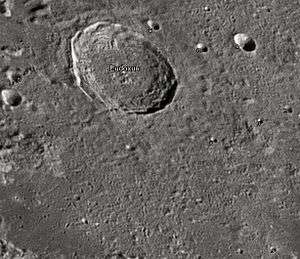Eudoxus (lunar crater)
|
Lunar Orbiter 4 image | |
| Coordinates | 44°18′N 16°18′E / 44.3°N 16.3°ECoordinates: 44°18′N 16°18′E / 44.3°N 16.3°E |
|---|---|
| Diameter | 67 km |
| Depth | 3.4 km |
| Colongitude | 344° at sunrise |
| Eponym | Eudoxus of Cnidus |
Eudoxus is a prominent lunar impact crater that lies to the east of the northern tip of the Montes Caucasus range, and is named after the Greek astronomer Eudoxus of Cnidus. At this location, on Earth, the crater appears nearly oval due to foreshortening, but the crater is actually nearly circular. It is located to the south of the prominent crater Aristoteles in the northern regions of the visible Moon. To the south is the ruined formation of Alexander, and the small crater Lamèch lies about 50 southwest or less than a crater diameter.
The rim of Eudoxus has a series of terraces on the interior wall, and slightly worn ramparts about the exterior. It lacks a single central peak, but has a cluster of low hills about the midpoint of the floor. The remainder of the interior floor is relatively level. Eudoxus has a ray system, and is consequently mapped as part of the Copernican System.[1]
From that location the Earth would appear in the lunar sky at 46 degrees above the horizon towards the south, in the east, it is seen more than 16 degrees towards the east.

Satellite craters
By convention these features are identified on lunar maps by placing the letter on the side of the crater midpoint that is closest to Eudoxus. Eudoxus A is to the northeast, Eudoxos B is north-northeast, Eudoxus D is nearly 50 km southwest just more than that crater's diameter north of Lamèch, Eudoxus E is to the east, Eudoxus G is to the northeast, Eudoxus J is further south-southeast and Eudoxus V is to the southeast.
| Eudoxus | Latitude | Longitude | Diameter |
|---|---|---|---|
| A | 45.8° N | 20.0° E | 14 km |
| B | 45.6° N | 17.4° E | 8 km |
| D | 43.3° N | 13.2° E | 10 km |
| E | 44.3° N | 21.1° E | 6 km |
| G | 45.4° N | 18.8° E | 7 km |
| J | 40.8° N | 20.2° E | 4 km |
| U | 43.9° N | 20.3° E | 4 km |
| V | 43.1° N | 18.9° E | 4 km |
References
- ↑ The geologic history of the Moon, 1987, Wilhelms, Don E.; with sections by McCauley, John F.; Trask, Newell J. USGS Professional Paper: 1348. Plate 11: Copernican System (online)
- Andersson, L. E.; Whitaker, E. A. (1982). NASA Catalogue of Lunar Nomenclature. NASA RP-1097.
- Blue, Jennifer (July 25, 2007). "Gazetteer of Planetary Nomenclature". USGS. Retrieved 2007-08-05.
- Bussey, B.; Spudis, P. (2004). The Clementine Atlas of the Moon. New York: Cambridge University Press. ISBN 978-0-521-81528-4.
- Cocks, Elijah E.; Cocks, Josiah C. (1995). Who's Who on the Moon: A Biographical Dictionary of Lunar Nomenclature. Tudor Publishers. ISBN 978-0-936389-27-1.
- McDowell, Jonathan (July 15, 2007). "Lunar Nomenclature". Jonathan's Space Report. Retrieved 2007-10-24.
- Menzel, D. H.; Minnaert, M.; Levin, B.; Dollfus, A.; Bell, B. (1971). "Report on Lunar Nomenclature by the Working Group of Commission 17 of the IAU". Space Science Reviews. 12 (2): 136–186. Bibcode:1971SSRv...12..136M. doi:10.1007/BF00171763.
- Moore, Patrick (2001). On the Moon. Sterling Publishing Co. ISBN 978-0-304-35469-6.
- Price, Fred W. (1988). The Moon Observer's Handbook. Cambridge University Press. ISBN 978-0-521-33500-3.
- Rükl, Antonín (1990). Atlas of the Moon. Kalmbach Books. ISBN 978-0-913135-17-4.
- Webb, Rev. T. W. (1962). Celestial Objects for Common Telescopes (6th revised ed.). Dover. ISBN 978-0-486-20917-3.
- Whitaker, Ewen A. (1999). Mapping and Naming the Moon. Cambridge University Press. ISBN 978-0-521-62248-6.
- Wlasuk, Peter T. (2000). Observing the Moon. Springer. ISBN 978-1-85233-193-1.
| Wikimedia Commons has media related to Eudoxus (lunar crater). |
